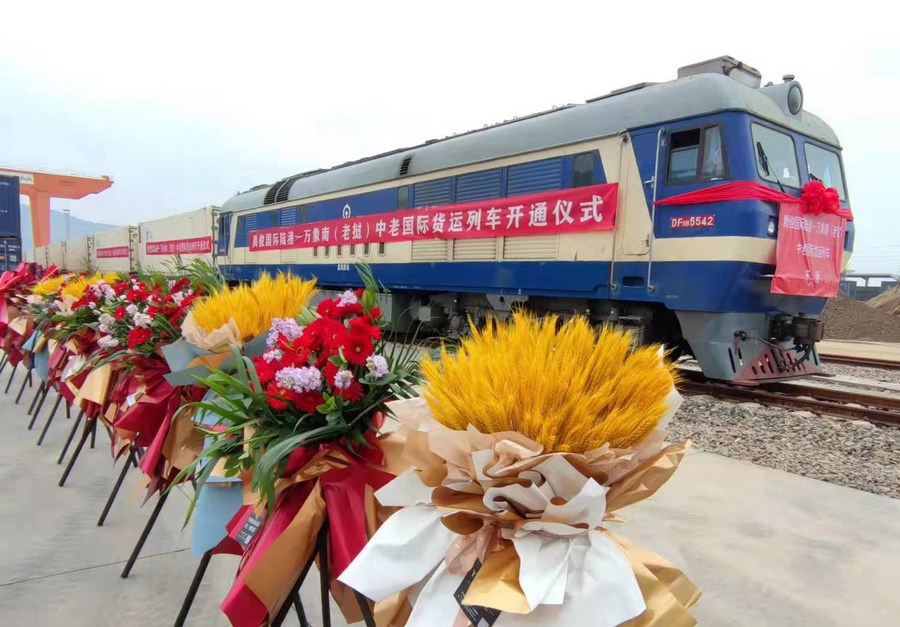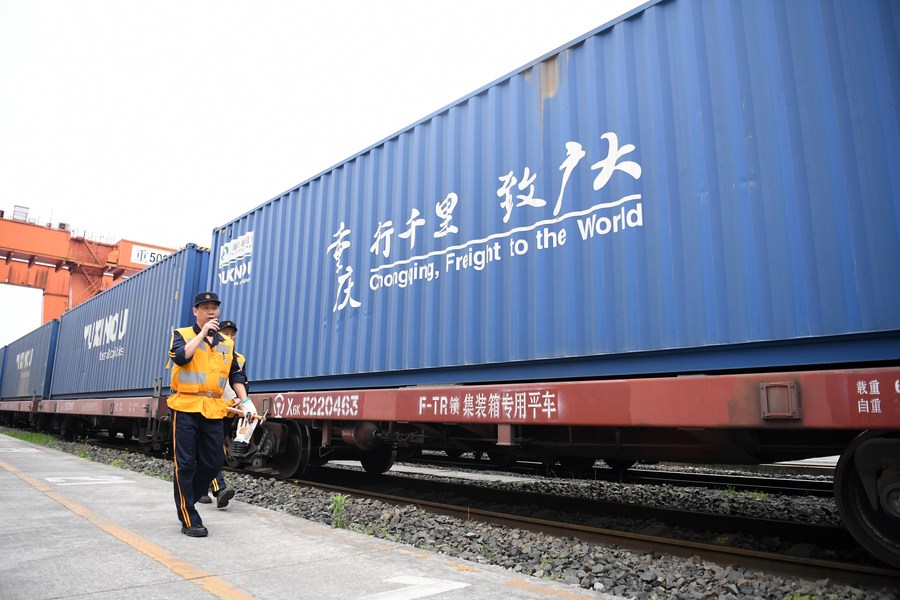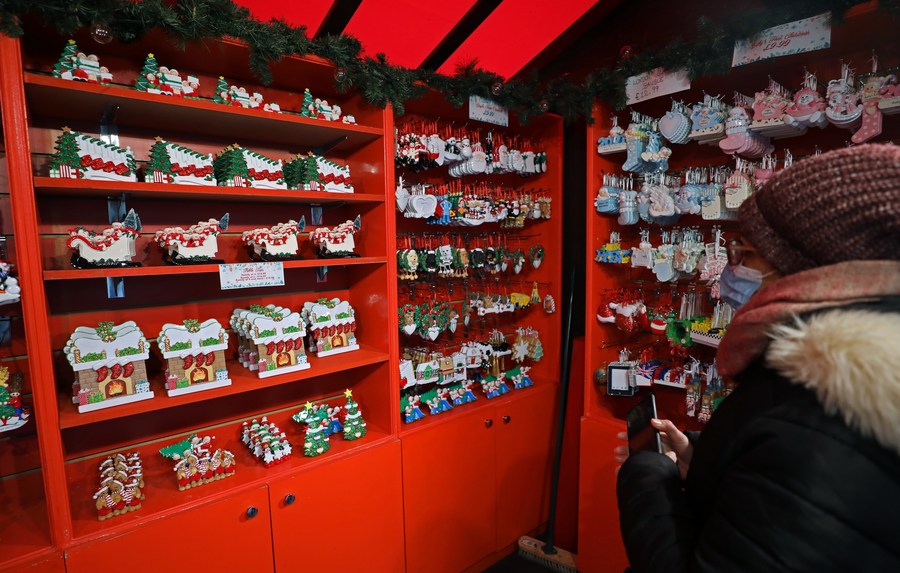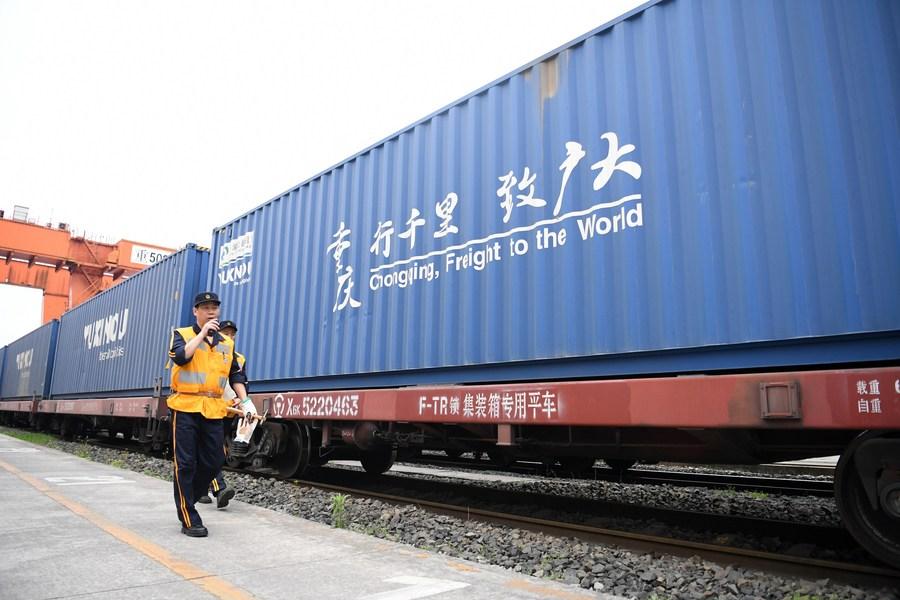
A train carrying 33 refrigerated containers departs from the Tengjun International Land Port in Kunming, capital of southwest China's Yunnan Province, for Laos, Dec. 4, 2021. (Xinhua)
- "China is very important for the global supply chain. And in most cases it's faster (than the ocean shipping). Therefore, it's a useful alternative to use the train, and it's reliable," said Axel Mattern, joint chief executive officer of Port of Hamburg Marketing.
- As of Dec. 16, China has signed more than 200 cooperation documents for the joint construction of the Belt and Road with 145 countries and 32 international organizations.
BEIJING, Dec. 26 (Xinhua) -- Though the world remains haunted by the still ravaging COVID-19 pandemic in the year 2021, the China-proposed Belt and Road Initiative (BRI) has seen a boom in promoting world connectivity.
Under the BRI framework, railway construction is expanding across the global landscape. The iconic China-Europe Railway Express, the China-Laos railway and the railway line in Tanzania have all recorded milestone achievements over the past year.
These important railway projects provide important pillars for the BRI, and also contribute their due share to improving the global supply chain and the COVID-19 fight.

Railway staff members check a Yuxin'ou (Chongqing-Xinjiang-Europe) China-Europe freight train before it leaves the Tuanjie Village Station of southwest China's Chongqing Municipality, March 19, 2021. (Xinhua/Tang Yi)
LINE OF HEALTH AND GIFTS
During days just before Christmas, when people in Western countries are worrying that they may not be able to receive their Christmas gifts on time due to clogged shipping lanes, China-Europe trains from different regions were sending products to Europe without delay.
This year marks the 10th anniversary of the launch of China-Europe freight trains. By the end of October, the China-Europe freight trains plying along 73 routes have reached 175 cities in 23 European countries with more than 50,000 kinds of goods.
Amid the pandemic, the number of China-Europe express trains as well as the volume of freight have continued to break new records.
Data from China's National Development and Reform Commission shows that during the January-November period, the railway service linking the two sides operated 13,817 trains, carrying 1.332 million twenty-foot equivalent units (TEUs), an increase of 23 percent and 30 percent respectively compared with the year 2020.

A woman views Christmas ornaments made in China in a Christmas market at Trafalgar Square in London, Britain, Dec. 23, 2021. (Xinhua/Li Ying)
At the end of November, the cumulative number of anti-epidemic equipment transported by the China-Europe freight trains reached 13.43 million pieces and 103,000 tons.
"China is very important for the global supply chain. And in most cases it's faster (than the ocean shipping). Therefore, it's a useful alternative to use the train, and it's reliable," said Axel Mattern, joint chief executive officer of Port of Hamburg Marketing.
According to global logistics company MEDILINK, the initial freight rate of the China-Europe rail network is often two-thirds higher than that of sea freight, but the current price is very competitive.
The current freight rates of the China-Europe freight trains are basically the same as those of sea freight, but it only takes nearly half the time, said Logistics industry insiders.

A Lao railway staff member welcomes passengers to board Lane Xang electric multiple unit (EMU) train of the China-Laos Railway at Vientiane Railway Station in Vientiane, Laos, Dec. 3, 2021. (Photo by Kaikeo Saiyasane/Xinhua)
KEY FOR TRANS-ASIAN CONNECTIVITY
On Dec. 3, the China-Laos Railway officially started operation. It marks a crucial step for the trans-Asian railway network, which has been brewing for more than half a century. Since then, the journey from Vientiane to the border with China has been reduced from 2 days to 3 hours, and the journey to Kunming, capital of China's Yunnan Province, can be made in a day.
"The China-Laos railway is conducive to promoting the development of areas that are located along the line. Countries in the Greater Mekong Subregion, including Thailand, Laos and China, will benefit from trade, agricultural products, consumer products, investment and tourism," said Pichet Kunadhamraks, deputy director-general of the Department of Rail Transport under the Thai Ministry of Transport, in an interview with Xinhua.
The railway is expected to reduce transport costs between Vientiane and Kunming by 40 to 50 percent, said a World Bank report, noting transport costs from Thailand's Laem Chabang port to Kunming are expected to fall by at least 32 percent.
It is estimated that by 2030, the annual volume of commercial goods in transit through the Laos section of the China-Laos Railway will reach 3.9 million tons, it added.
This year coincides with the 30th anniversary of the establishment of China-ASEAN dialogue relations, and the two sides are advancing the BRI and the Master Plan on ASEAN Connectivity 2025.
On Jan. 1, 2022, the Regional Comprehensive Economic Partnership (RCEP) will officially enter into force. Experts believe that the BRI will lead to the construction of the trans-Asian rail network and promote regional connectivity.

Passengers are seen at Nairobi station of Mombasa-Nairobi Standard Gauge Railway (SGR) in Nairobi, capital of Kenya, Nov. 17, 2021. (Xinhua/Dong Jianghui)
ROAD OF DEVELOPMENT
In mid-June this year, a ceremony was held to launch the Ithaca-Mwanza section of the Standard Gauge Railway of Tanzania's Central Line, the construction of which is undertaken by a Chinese company.
After the completion of this project, it will become an important route connecting Tanzania, Uganda, Rwanda, Burundi and other countries, providing a pathway to the Indian Ocean. It is of great importance for promoting the economic development of the countries in the region and improving the living conditions of the people.
From the Tanzania-Zambia railway built in the 1970s, to the Djibouti-Ethiopia and Mombasa-Nairobi railways, and the Standard Gauge Railway of Tanzania's Central Line, the joint efforts of China and Africa have created jobs, trade opportunities and a better investment environment, thereby contributing to local prosperity as well as to the improvement of the living conditions of the local residents.
As of Dec. 16, China has signed more than 200 cooperation documents for the joint construction of the Belt and Road with 145 countries and 32 international organizations, and financial institutions such as China-proposed Asian Infrastructure Investment Bank and Silk Road Fund have expanded financing channels for infrastructure construction.
According to Bambang Suryono, chairman of Indonesian think tank Asia Innovation Study Center, for many countries, a major obstacle to escape poverty is the weakness of transport infrastructure, and in this regard, China's success can set an example.




 A single purchase
A single purchase









